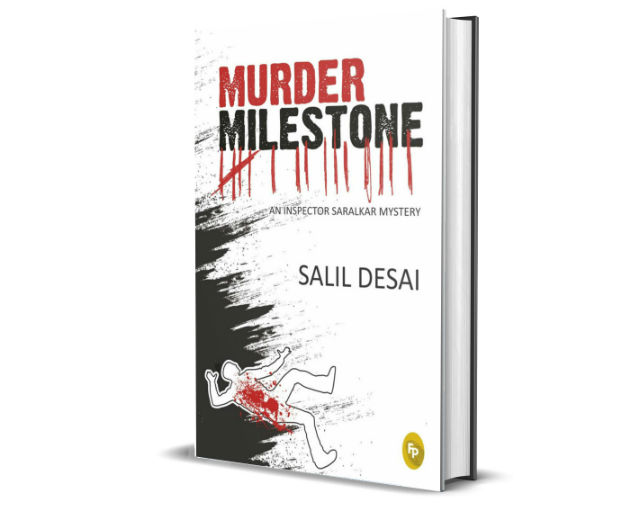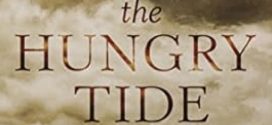Do you love reading Police Procedural? If your answer is “yes” and you have explored Indian books in this context then name of Salil Desai should not be unknown to you.
This Is Here In For You
Listen To The Podcast:
If you love to listen to the book review over reading, or if you want to go through it while doing other activity, here is our Podcast of this review article. Do listen, and share your thoughts with us.
Spotify:
YouTube:
If it is so, I will suggest you to read our unbiased Book Reviews for some of his works to know more about him and his work. And, if it is not, then also reading about Salil’s work will explore our perspective for the same to you. Here are the quick links:
Frankly speaking, writing a police procedural is a challenging job, and I found Salil’s works well-plotted, well-researched and more importantly well written. So, when we came to know about Murder Milestone, his latest in the genre, we couldn’t keep ourselves to let the book added to our review queue. Rather, we read it out of its turn. Fortunately, from our team, I got a chance to read it. And, I am thankful to my team for letting me break the queue. The views shared here are my personal and unbiased by all means.
| Book Title | : | Murder Milestone An Inspector Saralkar Mystery |
| Author | : | Salil Desai |
| Publisher | : | Fingerprint! Publishing (22 September 2020) |
| # of Pages | : | 320 (Paperback) |
| # of Chapters | : | 32 |
| Purchase Link(s) | : |
Let us take a look at the cover page of Murder Milestone.
Book Cover:
Of course, we believe in the saying “a book should not be judged by its cover”. But, at the same time, we also acknowledge the impact, a cover page can make (both positive and negative) and influence purchase and/or reading decisions.

Murder Milestone: An Inspector Saralkar Mystery By Salil Desai | Book Cover
If there had been a milestone shown somewhere near the body outline, it could have been more impactful, though.
Book Plot:
Let us take a bird’s eye view of the story.
Senior Inspector Saralkar and his aide PSI Motkar are considered as remarkable police officers when it comes to Homicide cases. They have to work odd hours for their policing job and their personal lives often suffer due to that. Well, at least Inspector Saralkar’s life for sure. His wife Jyoti got transferred to a different town where she goes daily by train. This additional time for the commute has added even more distance in their relationship.
Dharmesh Solanki is a killer of five men and three women: Anandibai Solkar, Chagan Bagle, Bajrang Pawar, Soundarya Bhise, Surajmal Kothari, Sambhaji Pimple, Najam Shaikh and Julie Kamat. Solanki was caught and investigated by Saralkar 16 years ago. Actually, his was the case that brought fame and recognition to Saralkar, who is now considered as an authority when it comes to Homicide cases. As it happens with most of such cases, Solanki’s case also has travelled through various courts and mercy pleas during recent times. As Solanki’s mercy plea is rejected, he is destined to be hanged within 4 weeks. And, it seems that finally, justice is going to be delivered.
Solanki makes a request to meet Saralkar before his death!
During the meeting, he reveals that his biography is about to be published, and he wants Saralkar to write the foreword for the same. Is it the only reason he wanted to meet Saralkar? Well, no. He also made a shocking claim during the meeting. What was that? Was he faking it or is there any truth in the claim? Can Saralkar ignore it? How does it affect the deteriorating personal life of Saralkar? PSI Motkar, now busy with a different case, will he join in his quest? Well, you need to read the book to get the answers.
To avoid spoilers, at least as far as possible, I cannot talk much about various threads of the story which are interesting and important. It is a thrilling ride, spread over in 32 chapters, where you meet Jyoti Saralkar, PSI Motkar, PSI Malusre, Uddhav Dandekar, Dharmesh Solanki, Sandeep, Vinay Sawant, Prachi Deshmukh, Digvijay Walke, Sandra Kamat, Maya, Saloni Mukherji, Ved Mathur, Appa Badime, Constable Bhilare, Constable Girhe, Raghav Dubhashi, Vikram Khare.
You also meet Mona Parab, Constable Dhole, Sriram Bidari, Atul Bidari, Baban Shigwan, Satyajit, Samuel Little – an African American arrested for 90 murders, among others. Also, there is a reason, I have listed these characters separately, they have a connection :).
And if you pay attention, you can find the initials of Saralkar for the first time! Yes, he is A N Saralkar, so it seems that the author has fulfilled a part of his promise made during our author interview with him :).
Views And Reviews:
This book is a treat for thriller lovers. Salil is one of only a few authors from India who write Police Procedural in English in a well-researched, convincing and fictional yet realistic manner. It is not a surprise that some new promising authors in this arena, like Arun Nair refer to him in high regard.
The strong points of the book are its plot and characters. We have seen in many books, movies and TV serials, that when exploring the serial killers, criminals, mafia and other dark characters, they, knowingly or unknowingly, glorifies them. And, sometimes make them larger than the life characters. The characters in this book are realistic in those terms. Be it the protagonists or antagonists, they have their share of strengths and weaknesses. And, that is how the real people are. And, thus, a thoughtful reader can easily connect with these characters.
Also, it is interesting to see that Motkar is not the main protagonist – the book is an Inspector Saralkar Mystery – he is also a strong character. He doesn’t need spoon-feeding of instructions. It is interesting to see Saralkar asking Motkar to go through his investigation report and find out anything he missed. Of course, with jibes and sarcasm. Motkar also never disappoints his superior, and always live up to his expectations. While he has an answer for all his boss’ sarcasm and jibes, he never crosses the line. He admires Saralkar’s work and methods with respect.
Same way, you can find almost all the characters, even the murder victims and killers, are explored in depth. Rather than exploring them as black or white, the author has given them shades of persona. For example, when you explore the tale of Sriram Bidari, you literally feel that life is unfair to him. When you read about a tragic situation when a victim’s son has to plead with the killer to release the property that belonged to the victim, so he can sell it and pay his dues, it shakes you. When exploring the case of cousins falling in love, you see the things that could have been rather avoided, becoming repeated to the point of “the wrong turn”. In fact, Saralkar and Motkar’s conversation about the “Karma” theory, is also not hypothetical, ideal or conclusive. But, it is realistic for sure. And yes, the interactions and non-interaction between the Saralkar couple are not to be missed.
The author is good at introducing various attributes of the character and his/her background. For example:
Dharmesh Solanki has been an Ayurvedic doctor when he embarked on his career as a murderer. He had set up practice in 1997 as a regular allopathic medic in a small village, about twenty-five kilometres from Wai town, which was at the foothills of the popular hill resort of Panchgani and Mahableshwar.
The author refers to “Mahabaleshwar” as “Mahableshwar” throughout the book. Probably, the locals might spell it that way.
The book brings in some philosophical lines from the killer’s mouth. There are multiple places where the author has elaborated the psyche of these tormented minds. You can find the lines exploring how high they held themselves in their own mind. Here is an interesting line from the book.
Killing is therapeutic, Inspector. … Believe me, I am not a psychopath. Not everyone who commits multiple murders is.
There are conversations elaborating on the “policing” where you can notice various elements as well.
“I told you I … don’t remember. Why should that matter? I have confessed to the murder, haven’t I?
Yes you have, … But the police need proof of the murder you have committed.
There are interesting verbatim and linguistics used in the book. For example:
“But you don’t like thermos tea,” she said with an encylcopaedic knowledge of husbandly contradictions that only a wife could store and retrieve at will.
Almost every couple will agree with it :).
The author found an interesting way to talk about certain attributes of his characters. For example:
… Motkar wondered why his boss felt the compulsive need to needle others.
In fact, the scene where Saralkar receives a call from CP’s office and he let it pass and then ask Motkar if he is doing the same with his calls, you see more of such stuff. And, if you think Saralkar cannot get philosophical and sarcastic at the same time, you should read these lines:
“Pretty spots like this are always dangerous, Motkar,” Saralkar replied. “Full of distractions for the poetic, the reckless, or the drunk. It’s a blessing most drivers are prosaic, timid souls, unmoved by breathtaking views.
This book is more of a psychological thriller than an action thriller. And yes, most actions happen inside the mind, sometimes they don’t get the physical form at all. Here is an interesting block that talks about how people think at a certain stage/situation.
“Yes… who knows what goes on in a desperate mind? My observation is that people who commit suicide, usually choose a method that they think they’ll be able to handle, without losing their nerve, which they believe will cause minimum pain and guarantees a quick death.
Here is one more interesting segment from the book that I would like to quote:
He paused and looked at PSI Motkar eagerly, like a dog looking for a pat after performing some trick.
These quotes must have given you a fair idea about the quality of writing you can expect from the book.
It is interesting to find a reference to “Police-Patil” in the book. It may not be very well-known to today’s reader, but such concept/posts were there in almost every state. In Gujarat, there were called “Police-Patel”, for example.
The author is an avid reader and he knows the right places to quote the reference. For example, you find references to Dr. Mengele, the infamous Nazi doctor who conducted horrendous medical experiments on Jews, Flora Rimaru and Ion Rimaru and many others. You can also find references of Raman Raghav, Auto Shankar, Cyanide Mohan, Mohinder Singh Pandher, Aadesh Khamra, Anjanabai Gavit and her two daughters Seema Gavit and Renuka Shinde, and even the recent Shina Bora case in the book.
The book also refers to a reality(!) show – Bad Boss (you are intelligent enough to make a connection) and talks about “The Silence of the Lambs” movie as well. The book talks about “the God syndrome”, and the Nazi slogan “Arbeit macht frei” meaning “work sets you free”. You will find references to BEOSP test, and the book explores the function of a helpline run by NGO for those who are feeling the urge to attempt suicide through – Chooselife helpline – a fictional one, in this book.
In short, I found almost everything a reader asks for in such a book.
The book has its own share of proofreading/formatting errors. For example
“Saralkarpuzzled.”
(page 232)
Also, you will find some questions are remaining unanswered (and hope to be answered in the next installment of this series), for example, was the lady (I will not mention her name) actually pushed from the train at the station, if yes, by whom? The book doesn’t have a preface or author’s note or even an index (as the chapters are not titled, you don’t miss it anyway – and naming chapters, might include spoilers, so we can ignore it). And, interestingly, you will not feel missing them.
Summary:
If you enjoy reading crime-thrillers / police-procedural, you will enjoy reading Murder Milestone for sure.
Around 8 to 8.5 stars out of 10.
Quick Purchase Links:
Over To You:
If you already have read the book do share your remarks and thoughts via comments below. Does this review help you in making your decision to buy or read the book? Do not forget to share this article with your friends over various social networks via Twitter, Facebook and others. And yes, you may like to subscribe to our RSS feeds and follow us on various Social networks to get latest updates for the site to land right in your mail box.
 ThinkerViews – Views And Reviews Personal views and reviews for books, magazines, tv serials, movies, websites, technical stuff and more.
ThinkerViews – Views And Reviews Personal views and reviews for books, magazines, tv serials, movies, websites, technical stuff and more.




I read this book and I did not find anything thrilling or chilling. There is no description of how the protege kills people or his modus of Operandi. There is no finale. When Saralkar creates fake news of finding the protege the real protege is so dumb that he simply surrenders himself. In the end, Saralkar explains to (Readers) Motkar how these Serial killers have low IQ and bullshit. Sounds like a CID episode. In reality, the serial killers are so intelligent that the smartest of the cops couldn’t find them. for example Zodiac serial killer.
Another serial killer in the book who is supposedly helping people commit suicide is so easy to catch and he openly tells his potential victim his plan of killing people. And Motkat creates the simplest of traps and arrests him.
How cops even start the investigation without dead bodies? Cops are not mind-readers. If Saralkar already knew that psychopathic serial killers have low IQ then why doesn’t he create this fake news at the beginning itself? why did they waste time in the investigation? They could have easily declared Dandekar as a serial killer and the Protege would have revealed himself?
Why the Dandekar character is there in the story? how he is affecting the plot? Why Jyoti has to fall from the train? How is it affecting the plot? This is such lame writing.
Hi Valay,
Thanks for stopping by sharing your views about this book on our platform.
Keep reading and sharing your views.
-Best
Team ThinkerViews